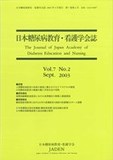Japanese
English
- 有料閲覧
- Abstract 文献概要
- 参考文献 Reference
- サイト内被引用 Cited by
本研究は,小児糖尿病患者の学校生活を含めた療養行動の実態を明らかにし,今後の看護支援・指導のあり方について検討することを目的とした.対象は,県内の医療施設を受診している9~18歳の1型糖尿病患者24名である.調査は自記式質問紙を用いて行った.療養行動に関して,兼松らの開発による糖尿病患者の療養行動質問紙を使用し,学校生活に関しては独自の質問項目を追加した.分析には,療養行動に関連する要因をみるためにPearsonの積率相関係数を,学年別3群間での比較には一元配置分散分析を用いた.結果は,療養行動総得点と食事療法,インスリン療法,自己血糖測定,低血糖,運動のカテゴリーに有意な正の相関がみられた(p<0.05,p<0.01).3群間の療養行動平均得点の比較では,小学生は中学生・高校生以上に比べ,「両親や家族の理解」において有意に高い値を示したが(p<0.05),「自分で低血糖の対処ができる」では有意に低い値を示した(p<0.05).また3群間での有意差は認めなかったが,小学生では「親との関係による療養行動」を含む項目,中学生・高校生以上では「自立」を含む項目の平均得点が高かった.昼食前のインスリン注射の実施は,小学生では全員保健室だが,中学生以上ではトイレ,ベランダでの実施もみられた.以上の結果から,小学生では親の管理から自己管理へ移行するための看護支援が必要であり,中学生・高校生以上では自己管理への自信を強化するために,疾患に関する知識や技術の再確認とともに思春期の特徴をふまえた情緒面への働きかけが必要であることが示唆された.
This study aims to clarify the self-care behavior of diabetic children as they practice it in school life in order to contribute to an assessment of current nursing support and establishing training for such support in the future. The subjects were 24 children with Type 1 diabetes who received medical examinations in prefectural medical facilities or who participated in a diabetes summer camp. Their ages ranged from 9 to 18 years. We surveyed the self-care behaviors of subjects with a questionnaire, in which they were asked to write the answers in their own words. We used the questionnaire developed by Kanematsu, et al., as well as our own questionnaire about school life. For analysis, Pearson's correlation was used for self-care behavior and one-way layout ANOVA was used for comparison among 3 age groups. The results showed a significantly positive correlation between total scores and dietary therapy, insulin treatment, self-monitoring of blood glucose, method of coping with hypoglycemia, and exercise (p<0.05). When the average scores for self-care behavior among the 3 age groups were compared, a significantly higher score for “comprehension of parents and families”was obtained for primary school children compared with junior and senior high school students (p<0.05). For“ability of subject him/herself to treat hypoglycemia”, however, a significantly lower score was obtained for primary school children. Primary school children had higher average scores for the items of self-care behavior in relation to parents. Junior and senior high school students had higher average scores of independence. For insulin injection before lunch time in school life, all the primary school children did so in the school infirmary. On the other hand, junior and senior high school students injected insulin either in the rest room or on the school veranda, or both. Our results might indicate that nursing support is necessary for primary school children in making the transfer from parent management to self-management and that for junior and senior high school students, emotional nursing support appropriatefor adolescent characters would be necessary in order to strengthen their self-confidence.
Copyright © 2003, Japan Academy of Diabetes Education and Nursing. All rights reserved.


